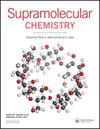甲氧基胺盐在一些有机非手性阴离子存在下的砾岩晶体形成:一种理论方法
IF 2.6
4区 化学
Q3 CHEMISTRY, MULTIDISCIPLINARY
引用次数: 0
摘要
采用密度泛函理论(DFT)研究了甲氧基胺对映体(R & S)与草酸盐、琥珀酸盐、富马酸盐、马来酸盐、戊二酸盐、己二酸盐、戊酸盐和亚酸盐等非手性有机试剂的相互作用。结果表明,草酸盐和马来酸盐阴离子在气相和氯仿、乙醇和水的溶液中形成甲氧基乙胺团状晶体的能力更强。能量分析结果表明,与气相和氯仿相比,在水和乙醇溶剂存在下,吉布斯能、焓和内热能变得更正,证实了溶剂极性对对映体分离的负面影响。还应注意的是,有机试剂中存在长度大于3个原子的碳链,不利于对映体的分离和砾岩晶体的形成。图形抽象本文章由计算机程序翻译,如有差异,请以英文原文为准。
The conglomerate crystal formation of methoxetamine salts in the presence of some organic achiral anions: a theoretical approach
ABSTRACT Density functional theory (DFT) calculations were made to investigate the interaction between enantiomers of methoxetamine (R & S) and achiral organic reagents, such as oxalate, succinate, fumarate, maleate, glutarate, adipate, pimelate, and suberate anions. The obtained results indicate that the oxalate and maleate anions have a greater ability to form conglomerate crystal of methoxetamine in the gas phase and in solution with chloroform, ethanol, and water. Results of the energy analysis reveal that, in comparison to gas phase and chloroform, the Gibbs energy, enthalpy, and internal thermal energy become more positive in the presence of water and ethanol solvents, confirming the negative effect of solvent polarity on enantiomer separation. It should also be noted that the presence of carbon-chain lengths greater than 3 atoms in organic reagents is not suitable for enantiomer separation and conglomerate crystal formation. . Graphical abstract
求助全文
通过发布文献求助,成功后即可免费获取论文全文。
去求助
来源期刊

Supramolecular Chemistry
化学-化学综合
CiteScore
3.60
自引率
3.00%
发文量
5
审稿时长
2.7 months
期刊介绍:
Supramolecular Chemistry welcomes manuscripts from the fields and sub-disciplines related to supramolecular chemistry and non-covalent interactions. From host-guest chemistry, self-assembly and systems chemistry, through materials chemistry and biochemical systems, we interpret supramolecular chemistry in the broadest possible sense. Interdisciplinary manuscripts are particularly encouraged. Manuscript types include: high priority communications; full papers; reviews, and; Methods papers, techniques tutorials highlighting procedures and technologies that are important to the field. We aim to publish papers in a timely fashion and as soon as a paper has been accepted and typeset it will be published in electronic form on the Latest articles section of the website. The two most important review criteria are that the paper presents high-quality work that fits generally into the broad spectrum of activities in the supramolecular chemistry field. Under normal circumstances, Supramolecular Chemistry does not consider manuscripts that would be more suitable in a highly specialized journal. This includes, but is not limited to, those based mostly or exclusively on topics such as solid state/X-ray structures, computational chemistry, or electrochemistry. .
The two most important review criteria are that the paper presents high-quality work that fits generally into the broad spectrum of activities in the supramolecular chemistry field.
 求助内容:
求助内容: 应助结果提醒方式:
应助结果提醒方式:


